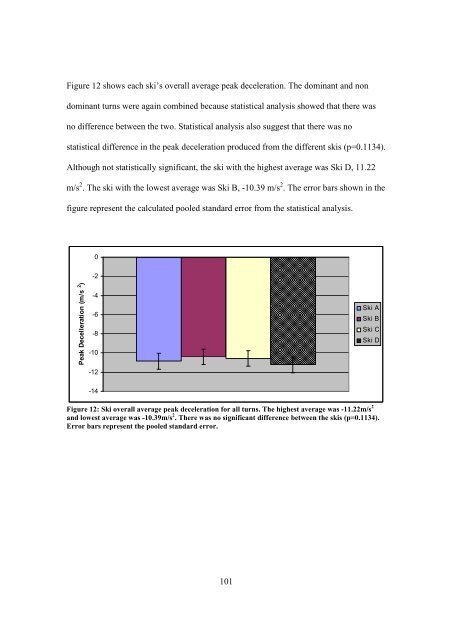- Page 1 and 2:
BIOMECHANICAL PERFORMANCE FACTORS O
- Page 3 and 4:
AcknowledgmentsI would like to star
- Page 5:
6.1 Conclusion and Future Considera
- Page 8 and 9:
83.42º·s and 48.92 º. There was
- Page 10 and 11:
List of TablesChapter 4Table 1: Sum
- Page 12 and 13:
1.1 The Basics of Water SkiingWater
- Page 15 and 16:
deep water start a good performance
- Page 17 and 18:
skills in order to be able to ident
- Page 19 and 20:
completed their test runs throughou
- Page 21 and 22:
1.5 Thesis outlineChapter 2 will pr
- Page 23 and 24:
Chapter 2: Literature Review13
- Page 25 and 26:
of material can be used as a force
- Page 27 and 28:
& Pesty, n.d.; Zang et al., 2004].
- Page 29 and 30:
instrumentation system used did not
- Page 31 and 32:
allowed them to plot a velocity ver
- Page 33 and 34:
Chapter 3: Methods and Instrumentat
- Page 35 and 36:
AbstractThere are many challenges w
- Page 37 and 38:
is most likely the main reason why
- Page 39 and 40:
applicable to dynamic sports [Brodi
- Page 41 and 42:
The product chosen that best met th
- Page 43 and 44:
ON) that did not require any modifi
- Page 45 and 46:
single data collection program that
- Page 47 and 48:
Figure 3 - Diagram of slalom course
- Page 49 and 50:
for patterns in the data that sugge
- Page 51 and 52:
200SU EC ST BTA150Angle (degrees)10
- Page 53 and 54:
10050Angle (Degrees)0-50-100-150Pit
- Page 55 and 56:
RF communication systems are easily
- Page 57 and 58:
The roll profile can be used to det
- Page 59 and 60: Chapter 4: Water Skiing Biomechanic
- Page 61 and 62: AbstractSix advanced slalom skiers
- Page 63 and 64: Recreational and competitive slalom
- Page 65 and 66: Table 1: Summary of human participa
- Page 67 and 68: Figure 2: Diagram of slalom course
- Page 69 and 70: at a rate of 1 Hz (BG-331RGTGT, Mig
- Page 71 and 72: adjusted p-value. (SAS Institue Inc
- Page 73 and 74: Table 3: Summary of completed turns
- Page 75 and 76: Rope load peaks during the cutting
- Page 77 and 78: Peak skier velocity for each turn i
- Page 79 and 80: 4 DiscussionThere are several varia
- Page 81 and 82: trend was seen by Runciman (2011) w
- Page 83 and 84: (p=0.2437 and p=0.246). It was expe
- Page 85 and 86: velocity and low peak rope load. In
- Page 87 and 88: improve the accuracy that a coach e
- Page 89 and 90: Chapter 5: Biomechanical Analysis o
- Page 91 and 92: AbstractWater skiing has received l
- Page 93 and 94: ski manufacturers ability to compar
- Page 95 and 96: given about how the effects of the
- Page 97 and 98: tip. The IMU housing was wrapped in
- Page 99 and 100: (roll, acceleration and deceleratio
- Page 101 and 102: decrease. This portion of the turn
- Page 103 and 104: Roll, Ski Acceleration and SkierVel
- Page 105 and 106: Integral of Roll, Peak Roll (degree
- Page 107 and 108: Integral of Roll, Peak Roll (degree
- Page 109: Integral of Deceleration (m/s 2 *s)
- Page 113 and 114: Integral of Acceleration, Peak Acce
- Page 115 and 116: Integral of Acceleration, Peak Acce
- Page 117 and 118: peak velocity is also occurring at
- Page 119 and 120: was not a significant difference be
- Page 121 and 122: The lack of statistical significanc
- Page 123 and 124: Chapter 6 - Conclusion and Future C
- Page 125 and 126: The data, in combination with a sta
- Page 127 and 128: Bachmann, E.R. (2000). Inertial and
- Page 129 and 130: Appendices119
- Page 131 and 132: Load Transducer Output (V)0.80.70.6
- Page 133 and 134: Skiing Background Information6. How
- Page 135 and 136: Section 2 - Follow up surveyPlease
- Page 137: Appendix C - Ski Survey ResultsThe
















